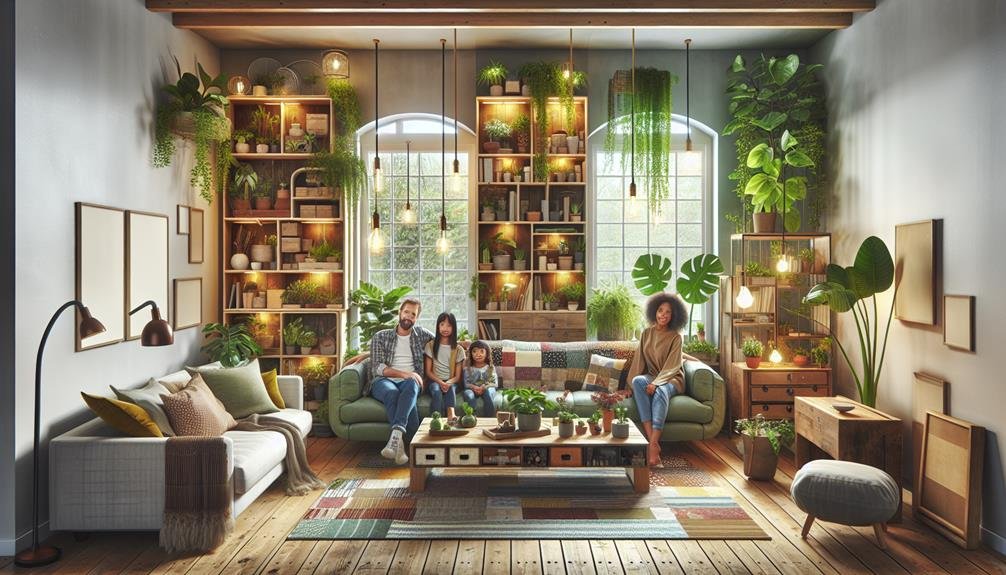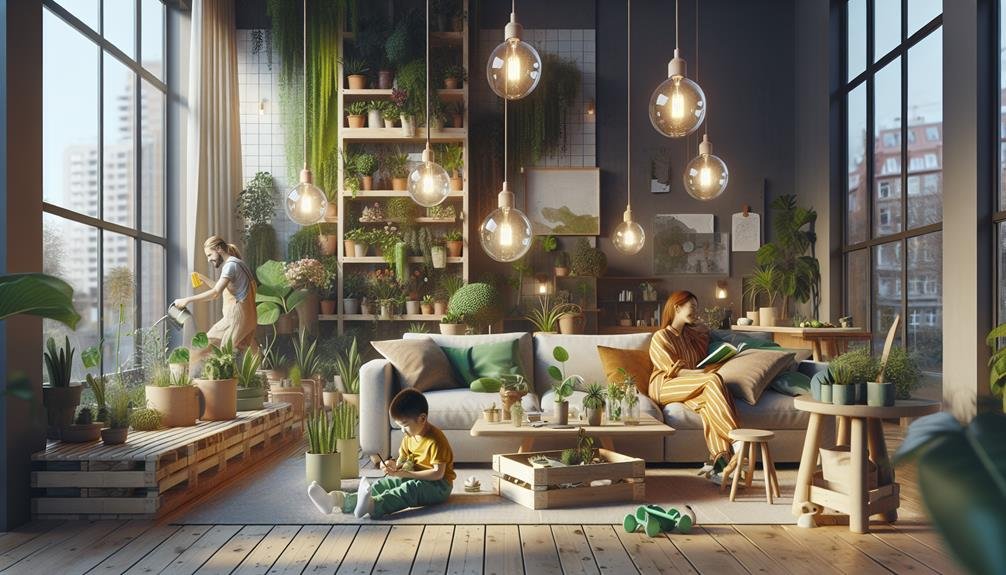Prioritizing eco-friendly home decor for families is a strategic choice that goes beyond mere aesthetics. The implications of adopting sustainable practices in household design extend far beyond the walls of a home, influencing the health and well-being of its inhabitants.
By considering eco-friendly options, families can actively contribute to a more sustainable future while reaping the benefits of a harmonious living environment.
The decision to prioritize eco-friendly home decor not only shapes physical spaces but also aligns with a broader ethos of responsible consumption and environmental stewardship.
Key Takeaways
- Eco-friendly decor promotes healthier indoor environments for families.
- Sustainable materials reduce energy consumption and utility costs.
- Choosing green decor supports ethical businesses and environmental responsibility.
- Prioritizing eco-friendly choices ensures long-term cost savings and a greener future.
Benefits of Eco-Friendly Home Decor
The adoption of eco-friendly home decor offers substantial advantages that not only enhance the well-being of families but also contribute positively to the environment. Sustainable materials play a crucial role in eco-friendly interior design, promoting a healthier home environment. By utilizing natural and recycled materials in home decor, families can reduce their environmental impact while enjoying a stylish and sustainable living space.
Green design practices prioritize energy efficiency, leading to lower utility bills and reduced energy consumption. Choosing eco-friendly decor supports businesses that prioritize environmental responsibility, fostering a sustainable lifestyle for families. Additionally, the use of low-VOC paints and natural fabrics in sustainable decor choices improves indoor air quality, creating a healthier living environment for all household members.
Incorporating eco-friendly elements into home design not only adds character and charm to living spaces but also minimizes the environmental footprint. By opting for eco-friendly decor, families can enjoy aesthetically pleasing interiors while contributing to a more sustainable future for both themselves and the planet.
Healthier Living Spaces for Families
Promoting healthier living environments for families, eco-friendly home decor reduces exposure to harmful chemicals commonly found in traditional furnishings. By incorporating organic fabrics and sustainable decor, families can enjoy a home that supports their well-being in various ways:
- Improved Indoor Air Quality: Eco-friendly materials and non-toxic furnishings help maintain a healthier indoor environment by reducing the presence of harmful pollutants.
- Prevention of Respiratory Issues and Allergies: Using organic fabrics and natural materials in home decor can prevent respiratory problems, allergies, and skin sensitivities among family members.
- Low-VOC Paints for Safer Spaces: Opting for Low-VOC paints ensures that the indoor air remains free from toxic compounds, contributing to a safer living environment.
- Environmentally Responsible Choices: Sustainable decor options not only enhance the aesthetic appeal of a space but also demonstrate a commitment to environmentally responsible living practices, benefiting both the family and the planet.
Prioritizing eco-friendly home decor is a proactive step towards creating a healthier living space for families, where comfort and safety go hand in hand.
Environmental Impact of Sustainable Decor

Reducing indoor air pollution and lowering energy consumption, sustainable decor choices have a positive environmental impact while enhancing the aesthetics of living spaces. By opting for sustainable materials such as low-VOC paints and natural fabrics, homeowners can significantly decrease indoor air pollution levels, promoting healthier living environments. Additionally, these eco-friendly decor choices help reduce energy consumption, leading to lower utility bills and a decreased carbon footprint.
Choosing sustainable decor not only benefits the environment but also supports eco-conscious businesses that prioritize ethical and environmentally friendly practices. By incorporating these eco-friendly options into home design, individuals can actively contribute to a greener future and promote a sustainable lifestyle for themselves and their families. Ultimately, prioritizing sustainable decor not only improves the quality of living spaces but also aligns with a broader commitment to environmental sustainability and responsible consumption.
Cost-Effectiveness of Eco-Friendly Choices
Enhancing financial sustainability through eco-friendly choices in home decor is a prudent investment strategy for long-term cost savings and environmental stewardship. When considering the cost-effectiveness of eco-friendly decor options, several key factors come into play:
- Energy-Efficient Appliances: Upgrading to energy-efficient appliances can lead to significant cost savings, with potential reductions in electricity bills of up to 30% over time.
- Sustainable Materials: Investing in sustainable materials such as bamboo or recycled glass for decor items can result in durable pieces that require less frequent replacement, ultimately saving money in the long run.
- Low-VOC Paints: While initially slightly more expensive, using Low-VOC paints in eco-friendly decor contributes to improved indoor air quality, potentially leading to health cost savings in the future.
- Organic Fabrics: Choosing organic fabrics for upholstery can reduce exposure to harmful chemicals, thereby potentially lowering healthcare expenses and contributing to a healthier indoor environment.
Creating a Sustainable Lifestyle at Home

To further cultivate a sustainable living environment within the household, families can implement eco-conscious practices that extend beyond cost-effectiveness and encompass overall well-being and environmental stewardship. Sustainable homes are achieved through using energy-efficient appliances, incorporating renewable energy sources like solar panels to lower electricity bills and reduce reliance on fossil fuels, and reducing overall energy consumption.
By choosing eco-friendly interior options such as low-VOC paints, organic fabrics, and natural materials, families can create a healthy environment with better indoor air quality for their loved ones, benefiting their health and well-being. These green practices not only contribute to lower utility bills but also instill a sense of responsibility in children, encouraging them to prioritize environmental consciousness from a young age.
Embracing sustainable living at home goes beyond just decor; it becomes a lifestyle that promotes a greener future for all.
Frequently Asked Questions
Why Is Sustainable Home Decor Important?
Sustainable home decor is crucial for a healthier living environment. It reduces indoor air pollution, lowers energy consumption, and supports businesses promoting environmental responsibility. Choosing eco-friendly materials not only enhances aesthetics but also minimizes the environmental footprint.
Why Is Eco-Friendly Design Important?
Eco-friendly design is crucial for reducing environmental impact, promoting health, and fostering sustainability. By utilizing natural materials, low-VOC paints, and energy-efficient options, eco-friendly decor enhances indoor air quality, lowers utility costs, and supports a greener future.
Why Might It Be Important to Build an Eco-Friendly House?
Building an eco-friendly house is crucial for sustainability, energy efficiency, and overall well-being. By prioritizing eco-friendly features in construction, families can enjoy reduced energy costs, improved air quality, and a smaller environmental footprint for a healthier and more sustainable living environment.
What Are the Benefits of Sustainable Interior Design?
Sustainable interior design offers numerous benefits such as improved indoor air quality, reduced energy consumption, lower utility bills, and minimized environmental impact. It promotes health, environmental responsibility, and enhances the overall aesthetics of living spaces.


